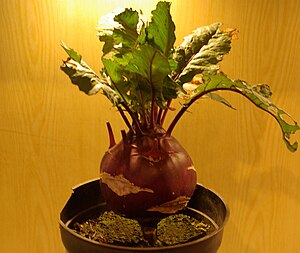| Kohlrabi |
|---|
 Kohlrabi stems with leaves removed |
| Species |
| Brassica oleracea |
| Cultivar group |
| Gongylodes Group |
| Cultivar group members |
| many; see text |
| Nutritional value per 100 g (3.5 oz) | |
|---|---|
| Energy | 113 kJ (27 kcal) |
| Carbohydrates | 6.2 g |
| Sugars | 2.6 g |
| Dietary fiber | 3.6 g |
| Fat | 0.1 g |
| Protein | 1.7 g |
| Water | 91 g |
| Vitamin C | 62 mg (103%) |
| Percentages are relative to US recommendations for adults. | |
The taste and texture of kohlrabi are similar to those of a broccoli stem or cabbage heart, but milder and sweeter, with a higher ratio of flesh to skin. The young stem in particular can be as crisp and juicy as an apple, although much less sweet. Except for the Gigante cultivar, spring-grown kohlrabi much over 5 cm in size tend to be woody, as do full-grown kohlrabi much over perhaps 10 cm in size; the Gigante cultivar can achieve great size while remaining of good eating quality. The plant matures in 55–60 days after sowing. Approximate weight is 150 g and has good standing ability for up to 30 days after maturity. It is tolerant to cracking.
Kohlrabi can be eaten raw as well as cooked.
There are several varieties commonly available, including White Vienna, Purple Vienna, Grand Duke, Gigante (also known as "Superschmelz"), Purple Danube, and White Danube. Coloration of the purple types is superficial: the edible parts are all pale yellow. The leafy greens can also be eaten.
Some varieties are grown as feed for cattle.[1]
Kohlrabi is one of the most commonly eaten vegetables in Kashmir.[citation needed] Locally called monj, the vegetable is eaten along with the leaves (haakh). A Kashmiri household may have this on their dinner or lunch plates three to four times a week.[citation needed] Monj (kohlrabi) is made in many forms. There is a spicy version which the Pandits call "dum monj", while as the nonspicy version is called Monj-haakh.[citation needed]







No comments:
Post a Comment